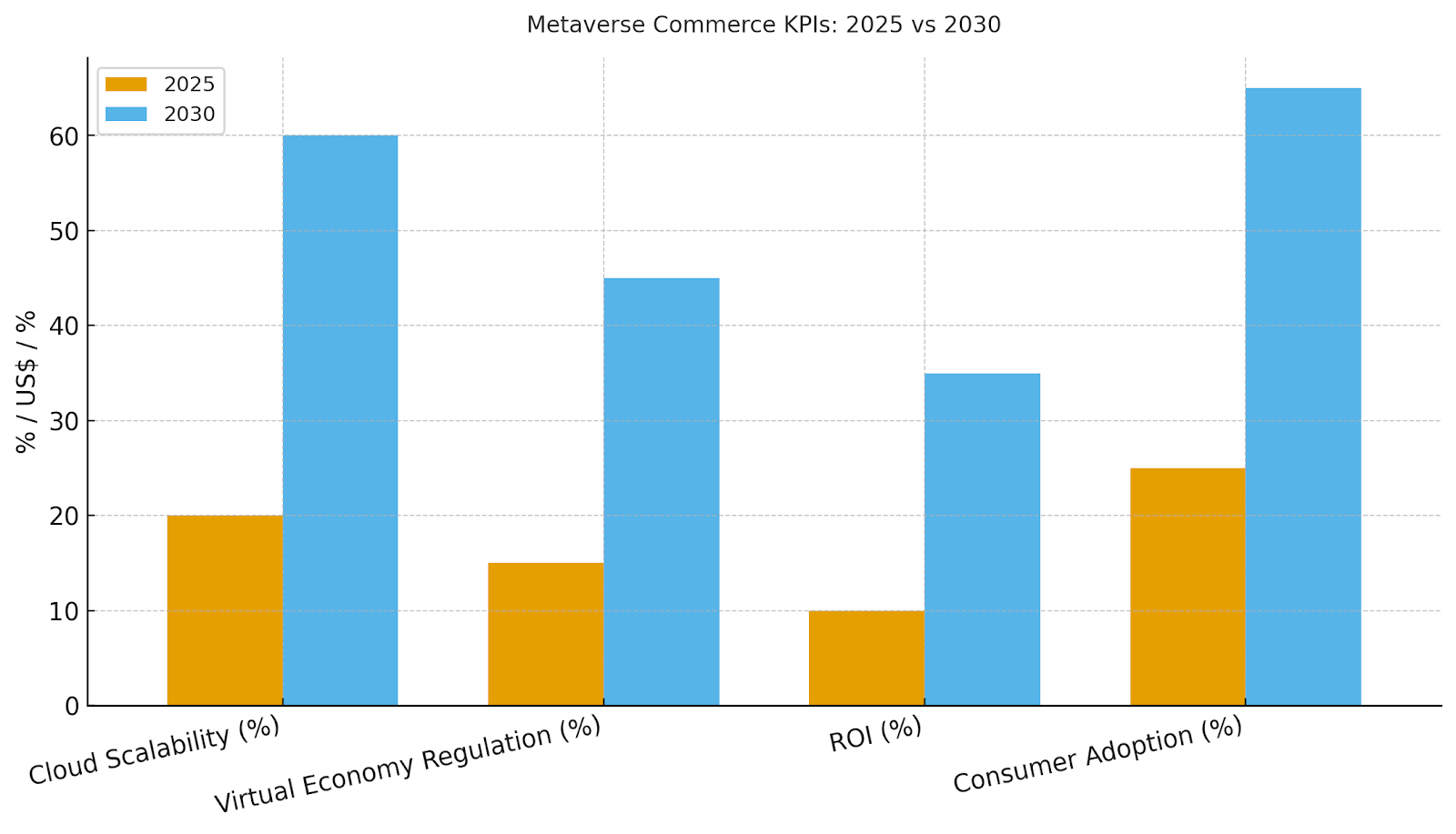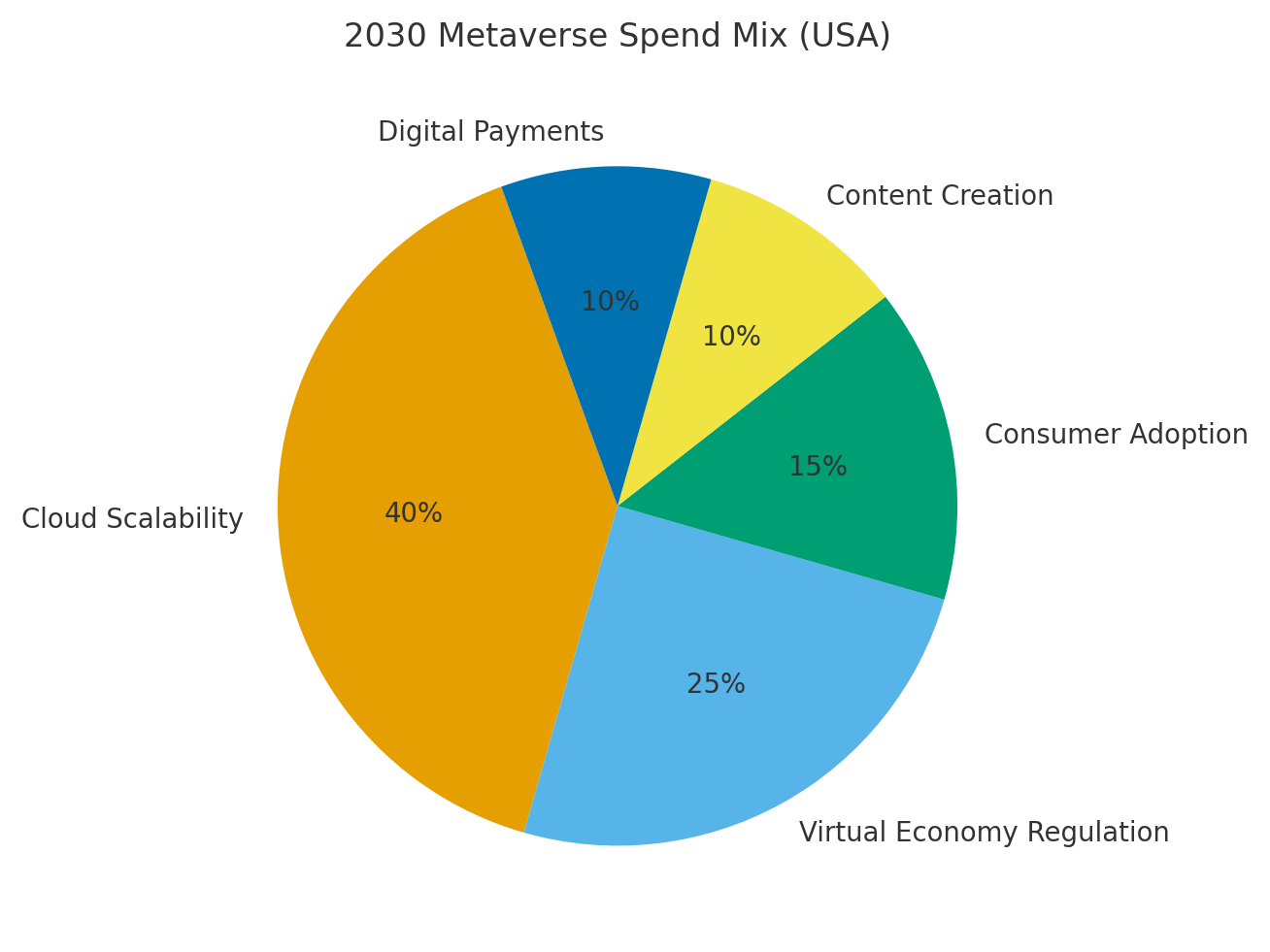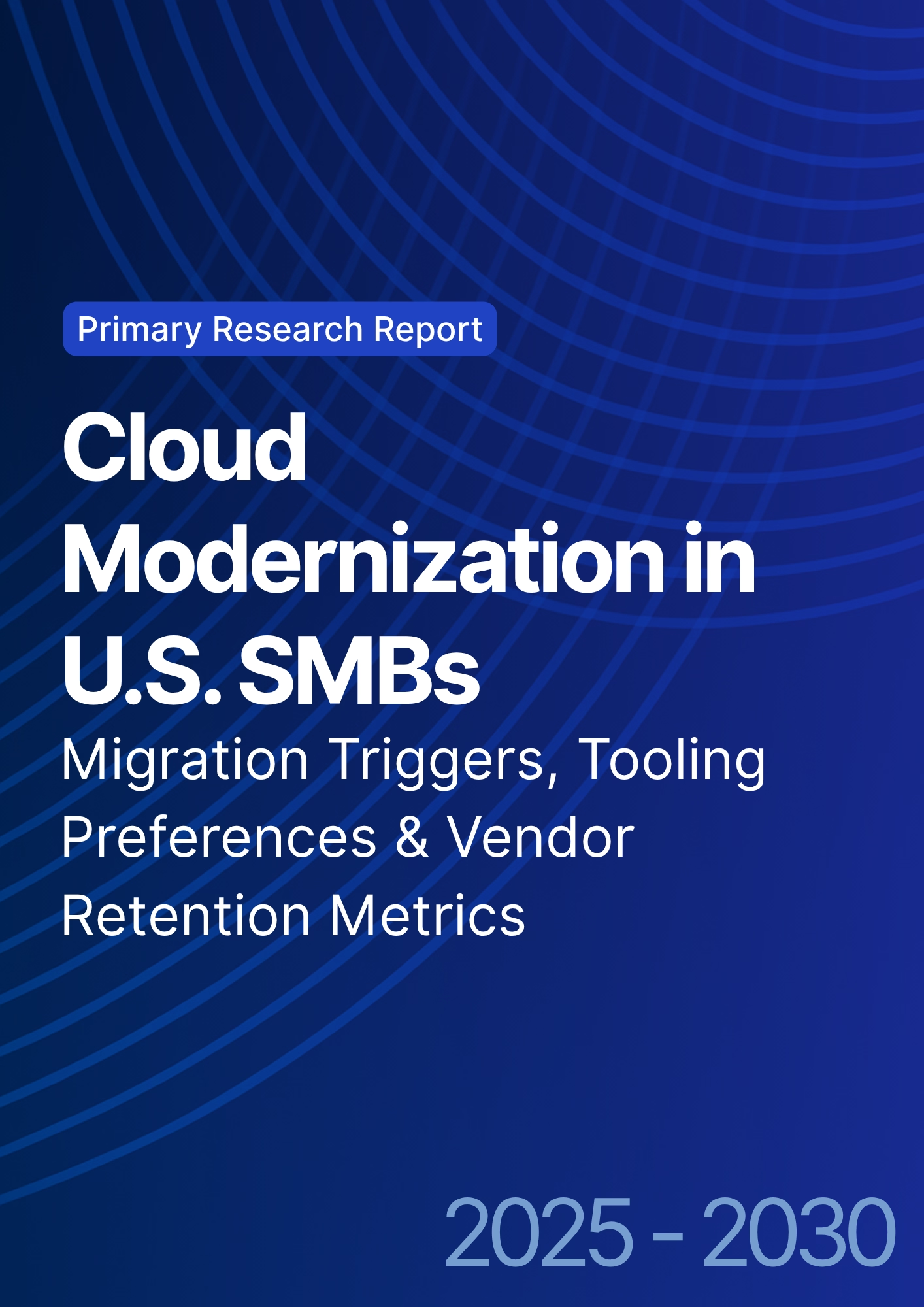

68 Circular Road, #02-01 049422, Singapore
Revenue Tower, Scbd, Jakarta 12190, Indonesia
4th Floor, Pinnacle Business Park, Andheri East, Mumbai, 400093
Cinnabar Hills, Embassy Golf Links Business Park, Bengaluru, Karnataka 560071
Connect With Us
Metaverse Commerce Platforms: Cloud Infrastructure Scalability & Virtual Economy Regulation
Metaverse commerce platforms are set to redefine digital business models, enabling immersive customer engagement and virtual economies. Market spending is projected to rise from ~$3.0B in 2025 to ~$11.3B by 2030, with adoption increasing from 22% to 75%. Consumer participation will grow from 25% to 65%, while ROI improves from 10% to 35%, fueled by personalized shopping, social interaction, and virtual marketing. Growth is driven by scalable cloud infrastructure and evolving regulatory frameworks. With secure cloud systems and compliance measures, the U.S. will lead this transformation, making the metaverse a cornerstone of future digital commerce.

What's Covered?
Report Summary
Key Takeaways
1. Metaverse spend increases from ~US$3.0B to ~US$11.3B by 2030.
2. Adoption rates rise from ~22% to ~75%, transforming digital engagement.
3. Cloud scalability improves from ~20% to ~60%, enabling large-scale adoption.
4. Virtual economy regulation increases from ~15% to ~45%, ensuring legal compliance.
5. Consumer adoption increases from ~25% to ~65%, driving platform usage.
6. ROI improves from ~10% to ~35% as businesses optimize metaverse platforms.
7. Content creation tools will become more advanced, enhancing user experiences.
8. The metaverse will become integral to business engagement strategies by 2030.

a) Market Size & Share
The metaverse commerce market in the USA is projected to grow from ~US$3.0B in 2025 to ~US$11.3B by 2030. This growth will be fueled by the increasing adoption of metaverse platforms for marketing, e-commerce, and entertainment. The adoption rate is expected to rise from ~22% in 2025 to ~75% by 2030, as businesses in various industries integrate metaverse experiences into their strategies. The growth in market size is attributed to increased consumer engagement, enhanced cloud scalability, and advancements in immersive technologies. The metaverse is becoming an essential tool for digital transformation, enabling companies to reach their customers in new and innovative ways. Risks include platform fragmentation and regulatory challenges, but they can be mitigated by selecting platforms that offer interoperability and aligning with regulatory standards.
The key benefit of investing in metaverse commerce platforms is the ability to engage customers in immersive, personalized experiences. The ability to scale cloud infrastructure effectively will be a critical factor in supporting growing metaverse environments, enabling businesses to handle increased traffic and create seamless experiences.

b) Market Analysis
The adoption of metaverse platforms is set to increase significantly in the coming years, driven by advancements in cloud infrastructure and growing consumer demand for immersive, virtual experiences. By 2030, adoption rates will reach ~75%, with businesses across industries using metaverse platforms for enhanced customer engagement, product discovery, and brand loyalty programs. The bar chart demonstrates key KPIs, including ROI, platform scalability, and consumer adoption. The biggest growth areas will be in cloud scalability, where businesses will leverage the metaverse to create immersive customer experiences at scale, and regulatory compliance, which will be critical as virtual economies expand. Risks such as cybersecurity concerns and legal issues around virtual currencies need to be mitigated through stronger platform security and adherence to international regulations.

c) Trends & Insights
1) The metaverse is expected to play a major role in transforming customer engagement, with businesses increasingly relying on immersive experiences to connect with consumers. 2) Cloud scalability will be a key driver, enabling businesses to support large-scale metaverse environments with seamless performance. 3) Regulatory compliance will be crucial in the development of virtual economies, with governments increasingly focusing on ensuring legal frameworks for digital assets. 4) Content creation tools will continue to evolve, providing businesses with advanced tools for creating rich, personalized experiences in the metaverse. 5) Businesses in industries like retail, automotive, and real estate will lead the way in adopting metaverse platforms to engage customers, create digital showrooms, and offer virtual services.
d) Segment Analysis
Sectors such as retail, e-commerce, gaming, and entertainment will be the primary drivers of metaverse commerce adoption. Retailers will leverage metaverse platforms to offer virtual shopping experiences, allowing customers to try products in virtual showrooms before making purchases. E-commerce platforms will integrate virtual reality (VR) and augmented reality (AR) features to improve product discovery and personalized recommendations. In the gaming industry, platforms like Roblox and Fortnite will continue to offer immersive environments that integrate e-commerce and gaming elements. Similarly, the entertainment industry will use the metaverse to provide interactive and live-streamed events, further driving consumer adoption.
Other sectors, such as healthcare, education, and finance, will also find applications for metaverse platforms, particularly in remote consultation, online learning, and digital financial services.
e) Geography Analysis
The USA is expected to lead global adoption of metaverse commerce platforms, with ~45% of global spend concentrated in the region by 2030. Key growth areas will be in e-commerce, retail, and entertainment, with significant contributions from the automotive and technology sectors. U.S.-based companies will be at the forefront of metaverse innovation, using immersive technologies to enhance brand engagement and customer experiences. The federal government’s regulatory frameworks for virtual currencies and digital economies will also play a crucial role in shaping the future of the metaverse.
By 2030, regions like Silicon Valley, New York, and Los Angeles will see the highest adoption rates of metaverse commerce platforms, as businesses in these areas lead digital innovation efforts. The regulatory environment will be key to ensuring that virtual economies operate in a compliant and secure manner, while driving global adoption of metaverse technologies.

f) Competitive Landscape
Key players in the metaverse commerce space include Microsoft, Meta (formerly Facebook), and Epic Games, along with specialized virtual platform providers like Decentral and The Sandbox. These companies are focusing on creating seamless, scalable platforms for metaverse experiences, with strong cloud infrastructure and data privacy features. Microsoft’s Azure, Meta’s Oculus, and Epic’s Unreal Engine are crucial technologies enabling these platforms. Additionally, companies like NVIDIA and AMD are developing hardware solutions to enhance the computing capabilities needed for metaverse environments. The competition will intensify as more players enter the market, and businesses will need to ensure they partner with platforms that can scale, ensure security, and provide a seamless experience.
Report Details
Proceed To Buy
Want a More Customized Experience?
- Request a Customized Transcript: Submit your own questions or specify changes. We’ll conduct a new call with the industry expert, covering both the original and your additional questions. You’ll receive an updated report for a small fee over the standard price.
- Request a Direct Call with the Expert: If you prefer a live conversation, we can facilitate a call between you and the expert. After the call, you’ll get the full recording, a verbatim transcript, and continued platform access to query the content and more.


68 Circular Road, #02-01 049422, Singapore
Revenue Tower, Scbd, Jakarta 12190, Indonesia
4th Floor, Pinnacle Business Park, Andheri East, Mumbai, 400093
Cinnabar Hills, Embassy Golf Links Business Park, Bengaluru, Karnataka 560071
Request Custom Transcript
Related Transcripts


68 Circular Road, #02-01 049422, Singapore
Revenue Tower, Scbd, Jakarta 12190, Indonesia
4th Floor, Pinnacle Business Park, Andheri East, Mumbai, 400093
Cinnabar Hills, Embassy Golf Links Business Park, Bengaluru, Karnataka 560071













